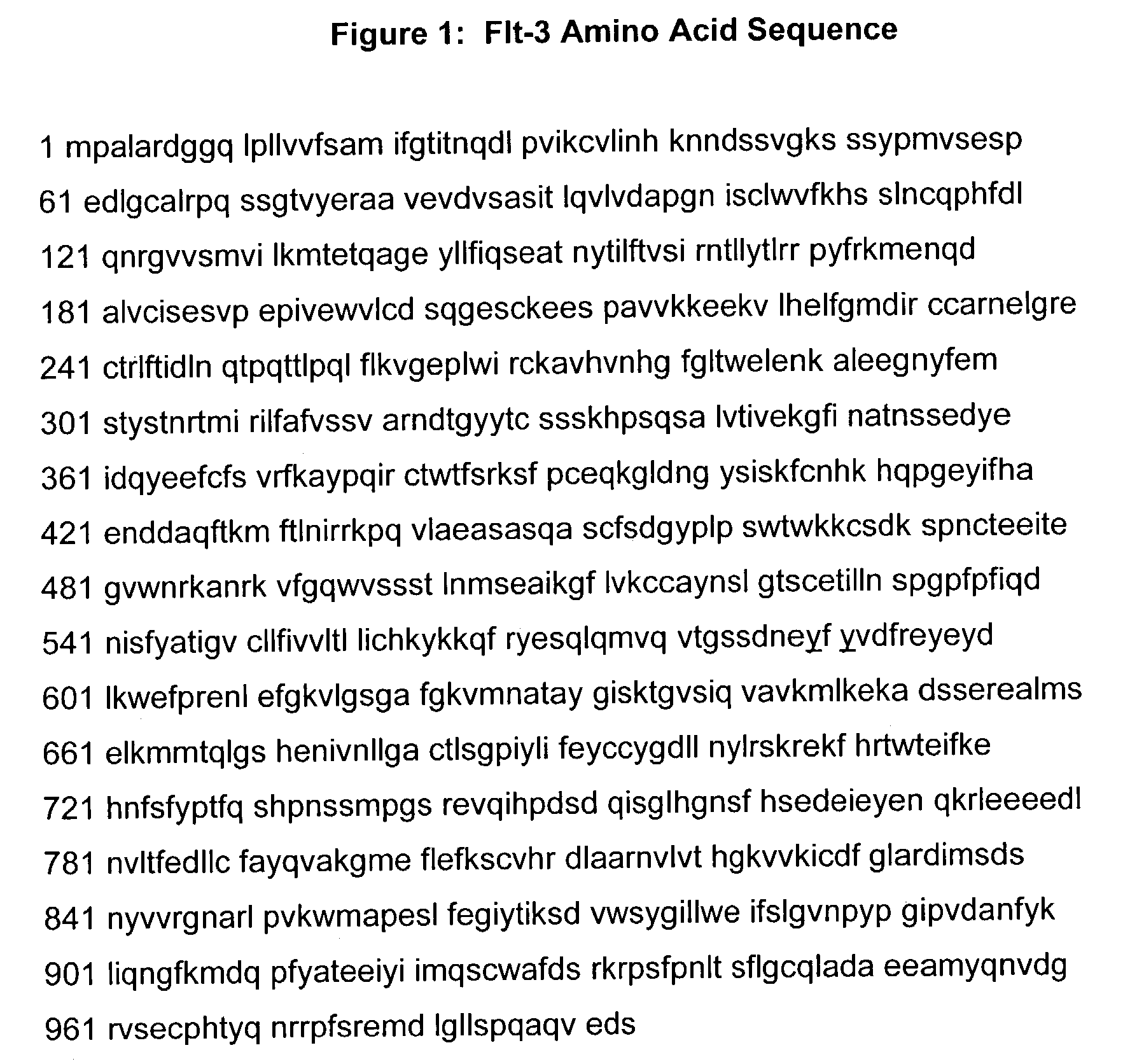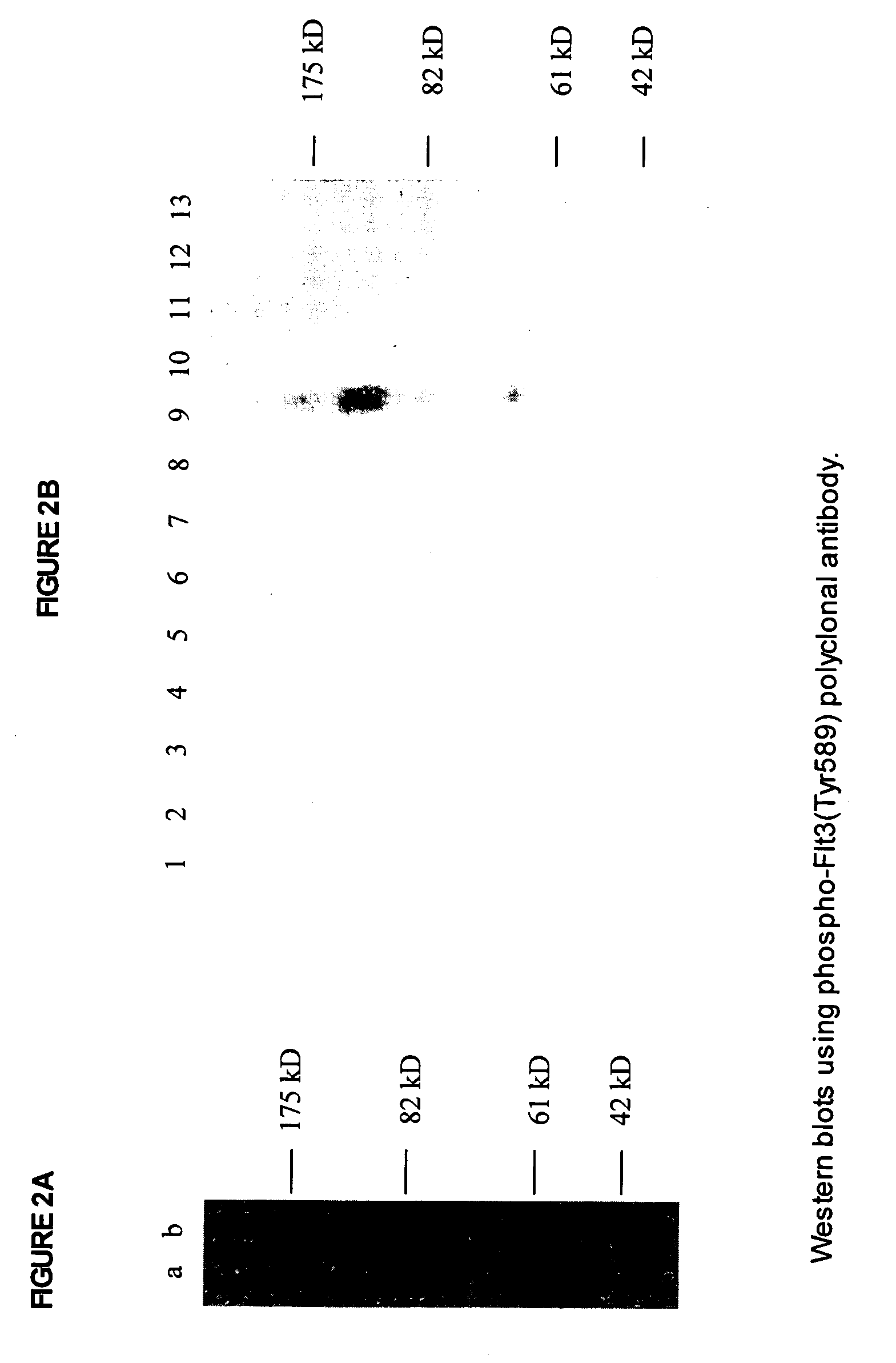Phospho-specific antibodies to Flt3 and uses thereof
a technology of phospho-specific antibodies and receptor tyrosine kinases, which is applied in the field of antibodies, can solve the problems of uncontrolled growth and proliferation of cancerous cells, and the inability of flt3 expression alone to correlate with patients,
- Summary
- Abstract
- Description
- Claims
- Application Information
AI Technical Summary
Problems solved by technology
Method used
Image
Examples
example 1
Production of a Flt3(Tyr589) Phosphospecific Polyclonal Antibody
[0050]A previously unknown Flt3 phosphorylation site, tyrosine 589, was discovered as described above by amino acid comparison to the Eph RTK family juxta-transmembrane domain, and confirmation as a putative kinase phosphorylation site using the ScanSite program. See Ybenga-Groot et al., supra.; Yaffe et al., supra. An 11 amino acid phospho-peptide antigen, CSDNEY*FYDVF (SEQ ID NO: 2) (where Y*=phosphotyrosine), corresponding to residues 585–594 of human Flt-3 (SEQ ID NO: 1) plus cysteine on the C-terminal for coupling, was constructed according to standard synthesis techniques using a Rainin / Protein Technologies, Inc., Symphony peptide synthesizer. See ANTIBODIES: A LABORATORY MANUAL, supra.; Merrifield, supra.
[0051]This peptide was coupled to KLH, and rabbits were injected intradermally (ID) on the back with antigen in complete Freunds adjuvant (500 μg antigen per rabbit). The rabbits were boosted with same antigen in...
example 2
Production of a Flt3(Tyr591) Phosphospecific Polyclonal Antibody
[0054]A second previously unknown Flt3 phosphorylation site, tyrosine 591, was discovered as described in Example 1, above, by protein sequence comparison to the Eph juxta-transmembrane domain. A 14 amino acid phospho-peptide antigen, CSDNEYFY*DVFREY (SEQ ID NO: 3) (where Y*=phosphotyrosine), corresponding to residues 585–597 of human Flt-3 (SEQ ID NO: 1) plus cysteine on the C-terminal for coupling, was constructed according to standard synthesis techniques using a Rainin / Protein Technologies, Inc., Symphony peptide synthesizer. See ANTIBODIES: A LABORATORY MANUAL, supra.; Merrifield, supra.
[0055]This peptide was coupled to KLH, and used to immunize rabbits, and purified over protein A as described in Example 1. Antibody having the desired specificity was purified by peptide-affinity chromatography using the DNEYFY*VDFREY peptide.
[0056]The phospho-Flt3(Tyr591) antibody was tested for phosphospecificity using Western bl...
example 3
Production of a Flt3(Tyr591) Phosphospecific Monoclonal Antibody
[0057]A Flt3(Tyr591) phosphospecific monoclonal antibody, CST #25-54, was produced from spleen cells of the immunized BALB / c mouse described in Example 2, above, following standard procedures (Harlow and Lane, 1988). The mouse was fused to SP2 / 0 mouse myeloma fusion partner cells according to the protocol of Kohler and Milstein (1975). Colonies originating from the fusion were screened by ELISA for reactivity to the phospho-peptide and non-phospho-peptide and by Western blot analysis. Colonies found to be positive by ELISA to the phospho-peptide while negative to the non-phospho-peptide were further characterized by Western blot analysis. Colonies found to be positive by Western blot analysis were subcloned by limited dilution. Mouse ascites were produced from the single clone obtained from subcloning. From the original fusion, 26 clones were found to be phospho-specific on ELISA. Only one of these clones was positive o...
PUM
| Property | Measurement | Unit |
|---|---|---|
| hydrophobic | aaaaa | aaaaa |
| aspartic acid | aaaaa | aaaaa |
| color | aaaaa | aaaaa |
Abstract
Description
Claims
Application Information
 Login to View More
Login to View More - R&D
- Intellectual Property
- Life Sciences
- Materials
- Tech Scout
- Unparalleled Data Quality
- Higher Quality Content
- 60% Fewer Hallucinations
Browse by: Latest US Patents, China's latest patents, Technical Efficacy Thesaurus, Application Domain, Technology Topic, Popular Technical Reports.
© 2025 PatSnap. All rights reserved.Legal|Privacy policy|Modern Slavery Act Transparency Statement|Sitemap|About US| Contact US: help@patsnap.com



